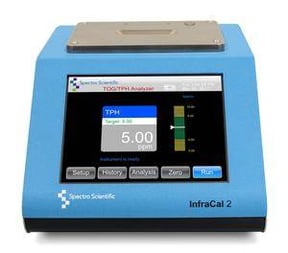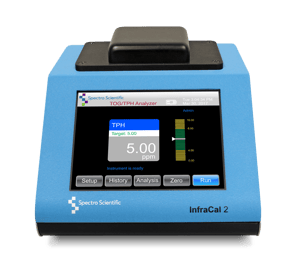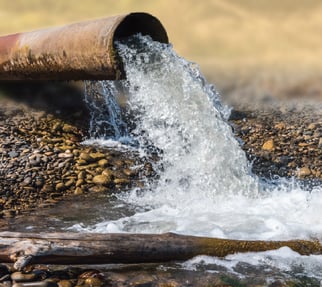 A Major Municipal Laboratory's analysts regularly perform Fats, Oil and Grease (FOG) measurements on wastewater samples from various industrial plants and apartment buildings. In the past, these measurements were all performed with Environmental Protection Agency (EPA) Method 1664B, which requires about 20 minutes of handling time per sample and 24 hours total to produce results.
A Major Municipal Laboratory's analysts regularly perform Fats, Oil and Grease (FOG) measurements on wastewater samples from various industrial plants and apartment buildings. In the past, these measurements were all performed with Environmental Protection Agency (EPA) Method 1664B, which requires about 20 minutes of handling time per sample and 24 hours total to produce results.
“A few years ago, we heard about infrared FOG measurement and wondered if it could save time and money,” said the Lab Manager. The laboratory performed a study that concluded that the infrared method using a Spectro Scientific InfraCal HATR-12 (now ATR-SP) infrared analyzer was at least as accurate as EPA Method 1664B. The laboratory now uses the infrared analyzer for most of its samples, which do not require EPA Method 1664B compliant measurements. Measuring FOG on an infrared analyzer requires only about five minutes of handling time and results are provided in another five minutes. Infrared measurement also requires 90 percent less solvent than EPA Method 1664B.
“The savings in manpower and solvent have more than paid for the infrared instrument in the two years that we have been using it,” the Lab Manager concluded.
Oil and grease represent major threat to sanitary sewers
The EPA has determined that grease from industrial sources, homes and restaurants is the most common cause of blockages leading to sanitary sewer overflows, causing 47% of reported blockages. These blockages create environmental problems, flood homes and businesses, tie up traffic and create millions of dollars in damages. The prime method of preventing these problems is controlling FOG discharges into sewer lines. The Department of Environmental Management regulations establish specific local limits for industrial users to guard against interference with the operation of municipal treatment works. The municipal laboratory serves the citizens of a major southern city and several surrounding rural utilities with water and sewer services. The board has about 50 different wells that are purified in three different plants and has three wastewater treatment plants.
EPA Method 1664 takes 24 hours to provide result
The municipal laboratory is responsible for testing FOG content of industrial customers such as automobile manufacturers, food processors, metal plating, and others on a monthly basis. They also are responsible for annually testing the discharge of approximately 100 apartment buildings in its service areas. The laboratory previously tested all of these samples using EPA Method 1664B for the determination of hexane extractable material (HEM) and silica gel treated hexane extractable material (SGT-HEM) in surface and saline waters and industrial and domestic aqueous wastes. A 1-liter sample is acidified to a pH of less than 2 and extracted with a solid phase extraction (SPE) disk using 100 ml of n-hexane. It takes about 10 minutes to prep each SPE disk with methanol and another 5 minutes to filter the sample through the filter. The extract is placed in a fume hood and then left to sit for about 24 hours. After the solvent evaporates, the remaining HEM is weighed and the results are calculated in parts per million (ppm), a process which takes another five minutes.
The EPA requires that the Method 1664 be used for certain samples but leaves laboratories free to use an alternate method for the vast majority of samples. “We felt the gravimetric method was highly dated and that it required too much time, solvent and manpower,” related the Lab Manager. “We looked at alternatives and discovered infrared technology.” The InfraCal HATR-12 is recommended for measuring oil and water, total petroleum hydrocarbons (TPH) in soil or FOG in wastewater with hexane, pentane or Vertrel MCA as the extracting solvent. The instrument is designed to correlate with EPA Method 1664B. It measures extracted hydrocarbons by passing infrared right through the sample. The hydrocarbons absorb infrared energy at a specific wavelength proportional to the concentration of oil and grease in the solvent. The analyzer can be calibrated to read out directly in the desired units.
Infrared analyzer provides results in 10 minutes
“Spectro offered to provide us with a demonstrator at no cost for one month,” explained the Lab Manager. “We spent much of that month testing various samples to compare its accuracy to EPA Method 1664B.” The first sample tested was a 40 ppm standard. The laboratory analyst pipetted 1 ml of stock 4 mg/mL n-hexadecane/ stearic acid (1:1) solution into 99 mL of deionized water, added 10 mL of hexane and shook the sample for 2 minutes. He waited until the sample partitioned, then used a pipette to exact 60 microliters from the top layer of the sample consisting of hexane mixed with oil and grease and deposited it on the sample plate of the instrument. He selected “run” and after the timer countdown of five minutes, the measurement result was displayed in ppm on the instrument screen. The measurements for this standard were very accurate and consistent at 42, 40 and 42 ppm with a recovery of 105%, 100% and 105%.
The analyst tested several industry composite samples using 250 mL of sample and 25 mL of hexane. Replicate results for these samples were very accurate as well. The first was a concentrated audit Quality Control (QC) from the EPA with a given concentration of 159 ppm. The analyst mixed 1 mL of the QC concentrate with 99 mL of DI water and 10mLs of hexane. The infrared instrument provided readings of 163, 150 and 165 ppm. A second test on the same sample provided one result that was unexpectedly high. The analyst noted that the instrument had been provided with instructions that it be re-zeroed every hour of use, and he had been using it for several hours without re-zeroing. He re-zeroed the instrument and got satisfactory results of 165, 143 and 159 ppm.
90% reduction in solvent usage
 EPA Method 1664B requires 100 ml of hexane for the extraction of a one liter sample. The amount of solvent cannot be reduced as the weight of the residual oil would be so low it would be less accurate for lower levels of oil and grease. With infrared analysis, only 60 µl of extract are required for analysis and the sample size can be reduced to 100 ml for a fairly well-mixed waste stream. This 100 ml volume only requires 10 ml of hexane for the extraction. In addition to a cost savings, reduced solvent usage means less exposure to solvent fumes for the operator and reduction in volatile fumes as a potential fire hazard.
EPA Method 1664B requires 100 ml of hexane for the extraction of a one liter sample. The amount of solvent cannot be reduced as the weight of the residual oil would be so low it would be less accurate for lower levels of oil and grease. With infrared analysis, only 60 µl of extract are required for analysis and the sample size can be reduced to 100 ml for a fairly well-mixed waste stream. This 100 ml volume only requires 10 ml of hexane for the extraction. In addition to a cost savings, reduced solvent usage means less exposure to solvent fumes for the operator and reduction in volatile fumes as a potential fire hazard.
Fixed filter infrared analyzers, such as the InfraCal 2 Model ATR-SP have a footprint of less than six by six inches, weigh less than five pounds and can be operated from a 12-volt power supply, allowing them to be operated from a vehicle battery or the internal battery. This means wastewater effluent testing can be done at the site – making it easier to catch high oil and grease offenders. By screening for out-of-compliance effluent discharges, the number of samples collected, transported and ultimately tested in the laboratory can be reduced.
 “At the end of our first month, we were confident in the ability of the instrument to accurately test for fats oil and grease,” stated the Lab Manager. “We purchased the instrument and have used it since then to test samples which do not require compliant measurements, and constitute the vast majority of our samples. The infrared method requires less manual handling which can create the potential for variance. In particular, the solid phase extraction step in EPA Method 1664B is highly dependent on the skill and attentiveness of the analyst. The infrared method is simpler to perform and for this reason in my experience it tends to deliver more consistent results and requires less training on the part of analysts.”
“At the end of our first month, we were confident in the ability of the instrument to accurately test for fats oil and grease,” stated the Lab Manager. “We purchased the instrument and have used it since then to test samples which do not require compliant measurements, and constitute the vast majority of our samples. The infrared method requires less manual handling which can create the potential for variance. In particular, the solid phase extraction step in EPA Method 1664B is highly dependent on the skill and attentiveness of the analyst. The infrared method is simpler to perform and for this reason in my experience it tends to deliver more consistent results and requires less training on the part of analysts.”
The lab manager concluded that the overriding benefits of the new instrument are time and cost savings. “The infrared analyzer provides results in 10 minutes start to finish compared to 24 hours for EPA Method 1664B,”. “This improvement makes it possible for our analysts to accomplish more in less time with the result that we have been able to accommodate an increasing work-flow without increasing our laboratory headcount. The 90% savings in solvent costs have also provided significant cost savings. The fact that the infrared analyzer provides results one day faster than EPA Method 1664 gives our organization a head start in reacting to FOG discharges. All in all, infrared measurements enable us to do a better job of preventing sanitary sewer overflows at a lower cost."



